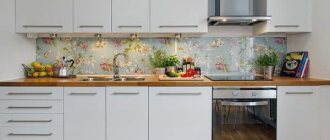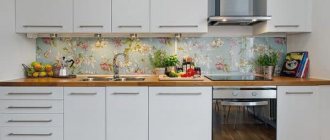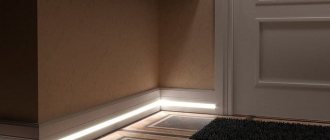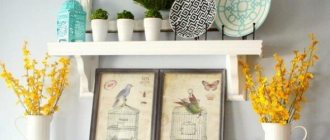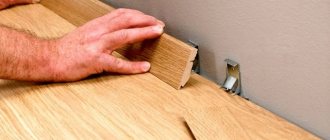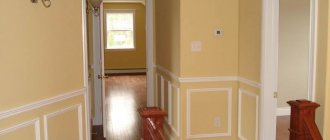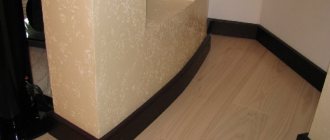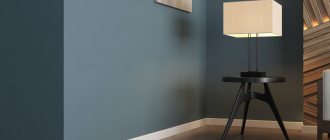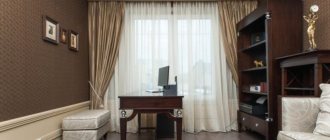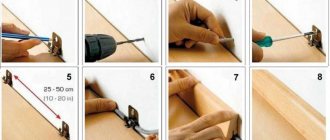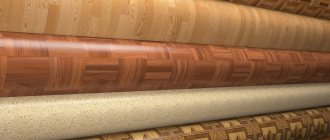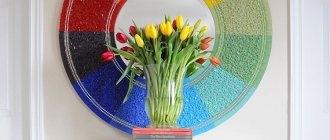A special plinth, which is fixed between the tabletop and the wall, has several purposes. Many people underestimate its importance, which is why they make a number of mistakes when purchasing and installing it. Today we are going to learn about how to attach a plinth to a countertop in the kitchen, and what is its peculiarity.
We fix the kitchen plinth with our own hands.
Why do you need a plinth on the tabletop?
It is the countertop that serves as a kind of springboard where processing, cleaning, and slicing of products takes place. And even if you use a board, there is no insurance against small pieces of food getting into places that are hard to reach for cleaning.
The baseboard protects the space between the furniture and the wall from small elements and debris getting there. The plinth covers the space between the furniture and the wall. This could be a corner or any other shape. This improves the aesthetic appearance of the kitchen. How to attach a corner to a tabletop and what types there are, we will consider further.
With the right baseboard, the aesthetic appearance of the kitchen improves noticeably.
Let's sum it up
Finding the best way is objectively difficult.
But I can draw the following conclusions:
- For solid plastic skirting boards, only fastening with glue is suitable;
- if it is a collapsible plastic flexible plinth, then you can use glue or self-tapping screws of your choice;
- You need to drill into the plastic carefully, and you shouldn’t screw a self-tapping screw directly into the plastic without a drill, otherwise it will crack;
- for aluminum baseboards, use self-tapping screws supplemented with sealant;
- if you plan to regularly move furniture and remove baseboards, then silicone will not work;
- try to mount the element to the countertop and not to the wall.
If you disagree with something, you can write in the comments. Let's discuss some additional issues.
- How to sell furniture active sales?
- Adhesive paper for furniture
- How to attach a countertop to a kitchen unit?
By the way, this article contains details about the choice of sealant for our purposes and more.
Which mounting option did you choose? Which skirting board do you prefer and why? Did you make any mistakes during installation, and what were they? What advice can you give to beginners?
All that remains is to hear your answers, as well as stories from your life.
Features and types of kitchen skirting boards
Masking the joint between the headset and the wall is not the only task of the plinth. And despite the importance of aesthetics, protection from moisture and damage to furniture also needs to be taken into account.
The baseboard also protects furniture from excess moisture. When purchasing a new kitchen, the kit includes wall furniture plinths, joints and plugs. But there are often cases when a headset is assembled into separate elements. In this case, the manufacturer will not supply the furniture with skirting boards, which automatically makes the selection of this element your responsibility. The variety of materials and shapes is enormous.
As a rule, baseboards are included with new kitchens. We invite you to consider three main ways to select profiles:
- The most common phenomenon is the selection of kitchen plinths based on the characteristics of the working surface. If you order profiles and joints based on numbers or decor names, please note that the shade may differ from one manufacturer to another.
- Identity of materials. This means that the baseboard is made by the manufacturer from the same material as the kitchen unit. For example: if the tabletop is made of wood, a profile is cut from the main board for ideal compatibility and visual creation of a monolith.
- Third method. This method is more designer, because the selection of skirting boards is carried out on the basis of its maximum similarity with the color of the handles and the type of material.
You can select a plinth for a tabletop according to several principles.
When choosing a profile, first of all take into account its physical properties. Each material is individual.
Plastic
Active demand for plastic products is due to durability, practicality and affordability. The manufacturer achieves aesthetics and texture for plastic skirting boards by lamination. Color is formed by adding pigment. Hence the huge number of shades and options for simulating natural materials: wood, metal, stone and others.
Plastic skirting boards are in great demand. Invoice options:
- smooth;
- gloss;
- matte and shagreen.
Plastic skirting boards can have all sorts of textures. Plastic is also valued for its ease of installation, because it bends and cuts quite simply. The main bonus is moisture resistance. In fact, water cannot harm plastic in any way. Profiles made from this material are easy to wipe clean.
Installation of plastic plinth is quite simple.
Aluminum
Thanks to the process of adonization (coating the surface of the slats with a special film), a good protective layer is formed: durable and moisture-resistant. Such profiles last much longer than the headset itself.
These skirting boards are durable and moisture resistant. PVC skirting boards have a drawback - they are “afraid” of exposure to high temperatures, which is not typical for aluminum. In addition, it is an electrical insulating material. The cost is slightly higher than that for plastic products.
One of the disadvantages is that they do not tolerate too high temperatures.
Metal-plastic
Metal-plastic products combine the advantages of previous profiles. Despite the advantages that aluminum and PVC models have, metal-plastic actually has no disadvantages. Among the possible ones: lack of flexibility (impairs the ability to hide wall irregularities with a tight fit) and some installation problems.
One of the main disadvantages of such skirting boards is that they are difficult to bend.
Functions of the decorative strip
- Protecting the joint from water - the cut of a sheet of chipboard or MDF is an open structure, vulnerable to moisture. Once inside, steam and drops destroy it. The edge swells and cracks. In addition, in conditions of constant dampness, it begins to rot. The result is an unpleasant odor that permeates the air and is transferred to items stored in the lower cabinets. Dampness spreads to furniture walls if their ends are not protected. Natural wood is less resistant to moisture. Unlike particle boards, it changes size and shape when wet and dry.
- Fixing the cabinet - it rests on an elastic gasket. This reduces the load on the legs when loosening. If the legs are unbalanced and the cabinet is wobbly, the elastic rail will prevent it from hitting the wall and protect it from destruction. It can be glued and screwed with self-tapping screws, creating a reliable, stationary mount.
- Decorative function - installing a kitchen plinth on the countertop allows you to close a gap with the wall that looks unattractive. Other methods are less effective.
Types of skirting boards by design
It is not only the type of material that allows you to classify skirting boards and influences their choice. There are differences in design. There are only such varieties: universal and cast profile. The characteristics of each type are important when choosing. And it’s fair to consider both options to get an objective picture.
The profile of the skirting boards can be cast and universal.
Universal
A design feature of universal skirting boards is the presence of silicone seals. The inserts are replaceable, and their appearance is decorative. The plinth is easier to change due to the type of joint. The protruding edge holders can be confusing. The length of the profile sections is on average 35 cm. It is quite convenient to install.
Universal skirting boards have a silicone seal.
Cast
The type of construction assumes an increased level of rigidity and massiveness. The absence of a silicone profile implies attachment to the seal. Among the visible advantages: long service life and presentable appearance. Their dimensions are almost 10 times larger than the previous version of the design.
Cast plinth is more durable and massive.
Installation methods
First, I will dwell on the design features of the moldings.
Kitchen baseboards can be solid or consist of a base strip and a removable element.
Choose dismountable kitchen baseboards.
Depending on the materials used, there are 2 types of fastening:
There are also different types of installation using self-tapping screws depending on where they are screwed:
Now you can separately see how to attach the plinth to the tabletop using self-tapping screws, and we will also take a separate look at the option with glue.
Fasten with self-tapping screws
There are also those who use nails. This is a wrong decision. If it is a flexible plastic baseboard, then you should not nail it to the tabletop. It is so easy to damage the molding itself, as well as the headset element.
Self-tapping screws are suitable for dismountable skirting boards. The installation sequence is as follows:
It is important that all possible gaps between the headset and the wall are filled with sealant.
If the molding becomes worn out, damaged, or simply becomes boring, it is not necessary to completely replace the baseboard. It is enough to remove the decorative trim and install a new one. At the same time, you can add a little sealant in places where it has worn out.
Fasten with glue
Mainly used for solid plastic skirting boards. Objectively, it is considered a simpler installation option.
An important condition is the purchase of high-quality adhesive-sealant. Nothing will work without him.
The step by step process looks like this:
That's all. The work is completed. Nothing complicated.
What are the differences and which type should you choose?
Composite section
The category is considered the most popular, including products made from aluminum, stainless steel and plastic. The profile is based on 2 parts: the back and front parts. In the first case, the role of the component is fixation (base). The decorative function is performed by the front side. There is also an option to introduce a third panel - decorative tape. It can imitate metal and countertop material.
Such skirting boards have two parts in the profile - front and back. Grooves are provided for tightly holding and fixing the decorative tape. Plastic parts are used as mounting elements.
Complete with:
- plugs (ensuring aesthetics);
- internal corner;
- outer.
Can be equipped with plugs and corners.
Calculate the number of installation kits in advance so as not to go to the store twice.
Solid section
Found in skirting boards such as borders. This class of products includes a wide variable range of products made to order. For example, artificial stone, granite, wood, ceramics, etc. Not very common, but included in the same group of skirting boards, are made of stainless steel.
The materials for making solid plinths can be almost anything. Disadvantages are manifested in high cost and the absence of a silicone seal. Processing and installation can also be considered disadvantages.
Disadvantages include high cost and complex installation.
Mounting methods
Before you begin installing the plinth, you need to familiarize yourself with the possible installation options for the product. All of them are so that, if necessary, the bar can be removed, for example, when temporarily moving a kitchen unit. But if the plinth is attached “tightly”, then this possibility will no longer exist.
Installation of wooden skirting boards
The first method involves fastening the baseboard to the tabletop, while the table itself is only pressed tightly against the wall, but is not secured with glue or screws. The second option is a little similar to the first, but now the baseboard needs to be attached to the wall, and it is only pressed against the surface of the countertop.
The plinth is attached to the tabletop
Important! When installing non-separable products, it is not customary to use fasteners, such as bolts or self-tapping screws. The shape of the moldings does not allow this. Therefore, for this purpose, sealants are used that simultaneously perform two functions - fixing and sealing the joint.
Features of installing skirting boards
If the design of the plinth is collapsible and it consists of two parts, then one of them must be attached to the surface of the tabletop or wall using small self-tapping screws. The second part neatly snaps onto the first.
How to attach a plinth to a tabletop
Among the main methods of fastening, there are 2 main ones: screws and glue. Here everything depends on the presence/absence of special holes for self-tapping screws, the characteristics of the material, its ductility, flexibility and other aspects. Let's consider both methods in detail.
You can attach the plinth using self-tapping screws or glue.
Fastening with self-tapping screws
This method is considered more reliable, so it is often chosen. Technical implementation is also not difficult.
This fastening method is considered the most reliable. Algorithm for fastening with self-tapping screws:
- The decorative panel must be separated from the base.
- Set the number of accompanying materials required for installation (plugs, corners).
- Lay out the structure (in fragments). This will help determine whether there are enough materials for the work and will indicate whether there is a need to adjust some of them to length.
- Not all baseboards have silicone seals. If they are missing, you need to degrease the surface of the countertop and apply a small layer of silicone.
- Installation work is carried out from the corner, along the surface of the tabletop. The step of fixing the base of the plinth with self-tapping screws should not exceed 30 cm, but it should not be less than 20.
- For reliable installation and optimal fixation, self-tapping screws are selected galvanized, or, if not available, brass. They are not afraid of metal corrosion.
- To ensure that the screws hold tightly, dowels are first driven into the wall into pre-prepared holes.
- The front strip is installed immediately after fixing the base. The ends of the plinth are covered with plugs for aesthetics.
The plugs may not always fit tightly. In this case, plant them with rubber glue or silicone.
It is better to fix the plugs with silicone or rubber glue.
Glue mount
Borders can be glued to the surface using liquid nails. If there is a need to glue skirting boards made of artificial stone, then you need to choose acrylic-based, two-component substances. To ensure that the joints remain invisible, the color of the glue is selected individually.
As a rule, liquid nails are used for gluing. The algorithm for carrying out the work does not differ from fastening with self-tapping screws, with the exception of:
- the need to degrease the surface for reliable fixation of the glue;
- the need to wipe off the remaining glue immediately until it dries (excess);
- there is no need to prepare connectors or drill anything.
On uneven surfaces you need to use more glue. In places where the surface is uneven, you need to use a thicker layer of glue. It's easier and faster to work with glue. But the screws still fix it stronger and more reliably.
Beautiful corner joints
note
It is important to arrange the corner joints beautifully, because otherwise dust and dirt will collect in the corners, the corners will not be secured and will constantly fall off.
If the working wall is smooth and the corners are 95 degrees, then there will be no problems. But if the walls are uneven, the edging will not adhere perfectly to the surface.
Before starting work, apply it to the base and identify problem areas. Place the joining corners in the corner; if something prevents them from fitting tightly, trim them using a painting knife.
If the corners are too uneven, the moldings will have to be installed without corner joints. You will have to attach the baseboards themselves and cut them at the desired angle. From two furniture borders an angle of 90 degrees is obtained.
Additional elements are divided into internal and external corners, as well as plugs.
A few words about natural stone borders
Construction stores also sell natural stone moldings. They have great strength, durability and resistance to high temperatures.
They are attached with glue; the base must be perfectly prepared. Not the most popular option due to its high cost.
Rules of care
The main function of the baseboard as a barrier is to prevent liquid or solid household waste, which has the ability to decompose under the influence of the kitchen microclimate, from getting into hard-to-reach places. Therefore, if gaps appear between the tabletop and the baseboard, they need to be eliminated. Transparent silicone is suitable for this.
It is important to ensure that no gaps form between the baseboard and the wall. Otherwise, there are no special care rules (except for the obvious - avoid contact with hot objects if the profile is PVC).
Why is this necessary?
Before attaching the baseboard to the tabletop, many are interested in why this is necessary.
Not everyone understands its functions and tasks. But in vain. An important and also necessary element in the kitchen.
There are 3 main functions:
These reasons are enough to take moldings from Leroy Merlin or another store and install them in your kitchen.
